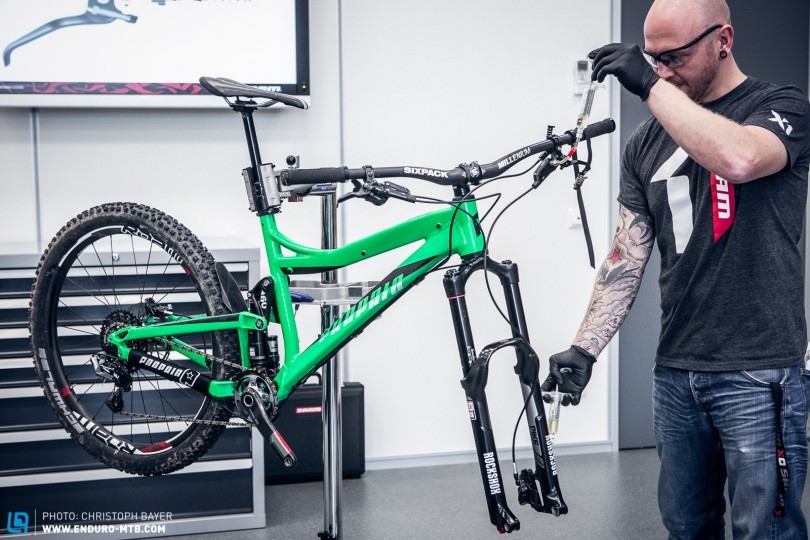If you’re experiencing a spongy brake lever, inconsistent bite point, or your SRAM Guide R brakes are over a year old, it’s time for a bleed. This guide provides a detailed, step-by-step approach on how to bleed your SRAM Guide R brakes effectively, ensuring optimal performance and safety.
Why Bleed Your Brakes?
Over time, air bubbles can accumulate in your brake lines, compromising hydraulic pressure and reducing braking power. Regular bleeding removes these air bubbles, restoring your brakes to their original performance. This is particularly crucial for brakes that use DOT fluid, as DOT fluid is hygroscopic and absorbs moisture from the environment which can degrade braking performance.
Skill Level: Intermediate
Tools and Materials:
- SRAM/Avid bleed kit (includes syringes, fittings, and bleed block)
- DOT 5.1 brake fluid (check your brake manufacturer’s specifications)
- Gloves
- Protective eyewear
- Zip ties or straps
- Clean rags
- Isopropyl alcohol (for cleaning)
Step-by-Step SRAM Guide R Brake Bleeding Guide
-
Preparation:
- Remove the wheel from your bike. This provides easier access to the caliper.
- Clean the brake lever and caliper area with isopropyl alcohol and a clean rag to remove any dirt or debris. This prevents contamination of the brake fluid.
-
Syringe Preparation:
- Prepare two syringes from your bleed kit.
- Fill one syringe approximately half full with fresh DOT 5.1 brake fluid.
- Fill the other syringe about one-third full with fresh brake fluid.
- Important: Ensure both syringes are free of air. Point the syringe upwards, gently tap the side to dislodge any bubbles, and then carefully push the air out.
-
Removing Air from Syringes:
- With the syringes filled, close them off at the top.
- Create a vacuum by pulling the syringe plunger. This will draw out any remaining air bubbles from the brake fluid.
- Repeat this process until no more air bubbles appear in the syringe.
-
Adjust Brake Lever:
- Locate the bite point adjuster on your brake lever.
- Turn the bite point adjuster to its maximum position (away from the arrow). This ensures a consistent and complete bleed.
-
Positioning the Brake Lever:
- Position the brake lever so it points downwards.
- Use a zip tie or strap to secure the brake lever close to the handlebar. This helps to prevent air from entering the system during the bleeding process.
-
Preparing the Caliper:
- If you have new brake pads: Use the transport guard (bleed block) that came with your brakes.
- If your brake pads are worn: Remove the brake pads from the caliper.
- Insert the bleed block into the caliper. This will keep the pistons from extending during the bleed.
-
Attaching the Syringes:
- Locate the bleed ports on the brake caliper.
- Remove the lower bleed port screw.
- Attach the syringe that is half-full with brake fluid to the lower bleed port.
- Remove the upper bleed port screw.
- Attach the remaining syringe to the upper bleed port.
-
Pushing Fluid Through the System:
- Gently push approximately 5-10 ml of brake fluid from the lower syringe, up through the system, into the upper syringe.
- Important: Double check that the lower syringe is free of any air before pushing the fluid.
-
Bleeding the Caliper:
- Carefully create a vacuum with the lower syringe, pulling fluid from the caliper. This helps to remove trapped air from the system.
- Continue to gently pull and push fluid through the system, alternating between the upper and lower syringes.
- Check for any air bubbles in the fluid being extracted.
-
Bleeding the Lever:
- Release the zip tie or strap holding the brake lever.
- Slowly allow the lever to return to its normal position while simultaneously applying pressure to the lower syringe.
- Create a slight vacuum with the upper syringe to bleed the lever.
-
Finalizing the Bleed:
- Close off the upper syringe.
- Remove the lower syringe and re-install the bleed port screw. Torque to the manufacturer’s specification.
- Remove the upper syringe and re-install the bleed port screw. Torque to the manufacturer’s specification.
-
Cleaning and Reassembly:
- Clean any spilled brake fluid from the lever and caliper with clean water.
- Return the brake lever to its original position.
- Re-install the brake pads (if removed).
- Re-install the wheel.
Conclusion
Bleeding your SRAM Guide R brakes is a straightforward process that can dramatically improve your bike’s performance and your safety on the trail. By following these steps carefully, you can achieve a firm lever feel and reliable braking power. Remember to always use fresh DOT fluid and take necessary safety precautions.
Disclaimer: This guide is for informational purposes only. If you are not comfortable performing this procedure, it is recommended to take your bike to a qualified mechanic.
